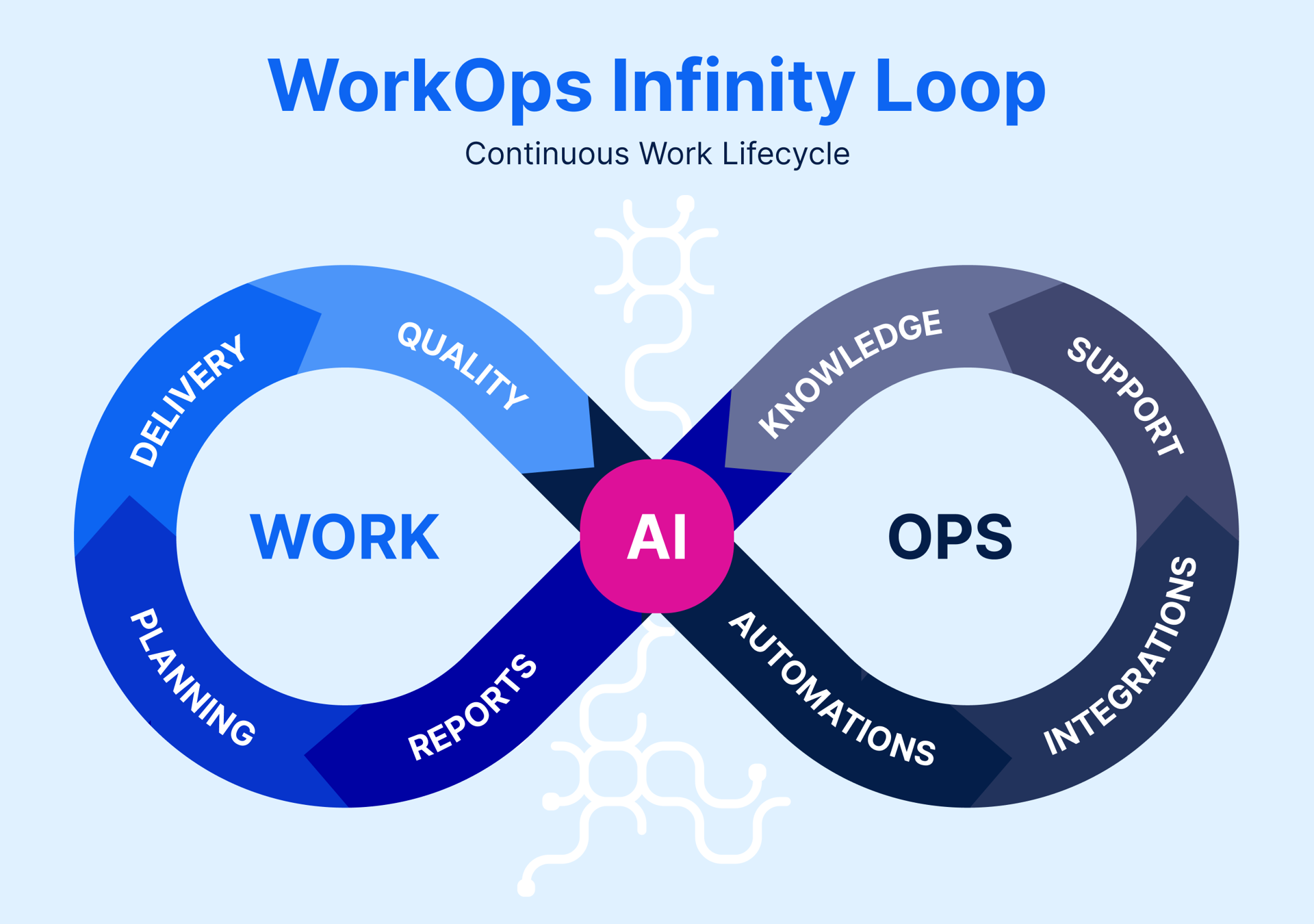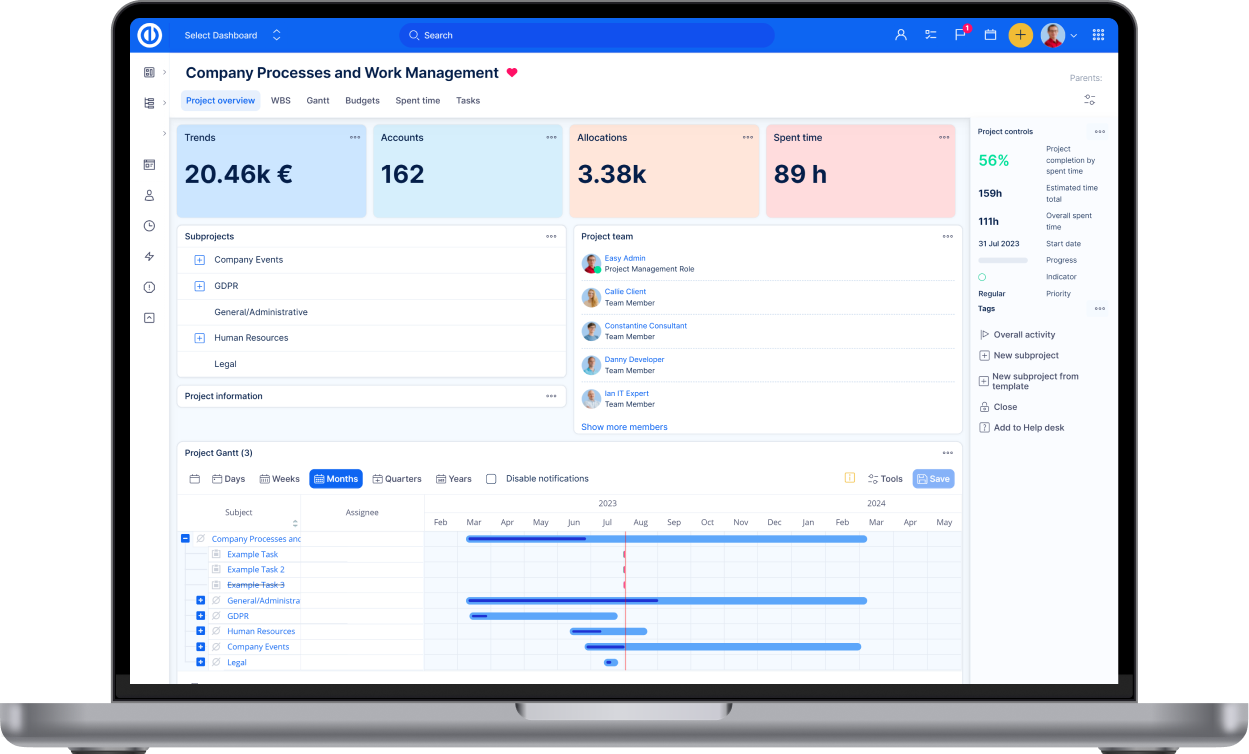Why is project management not enough? Future of WorkOps explained
Traditional project management was built for a predictable, linear world that no longer exists. Today's problems—siloed teams, tool fragmentation, and rapid change—require an ecosystem approach, not project-by-project oversight. WorkOps creates an intelligent, interconnected work environment where automation, AI and humans combine to deliver continuous value. Let's deep dive into the topic.
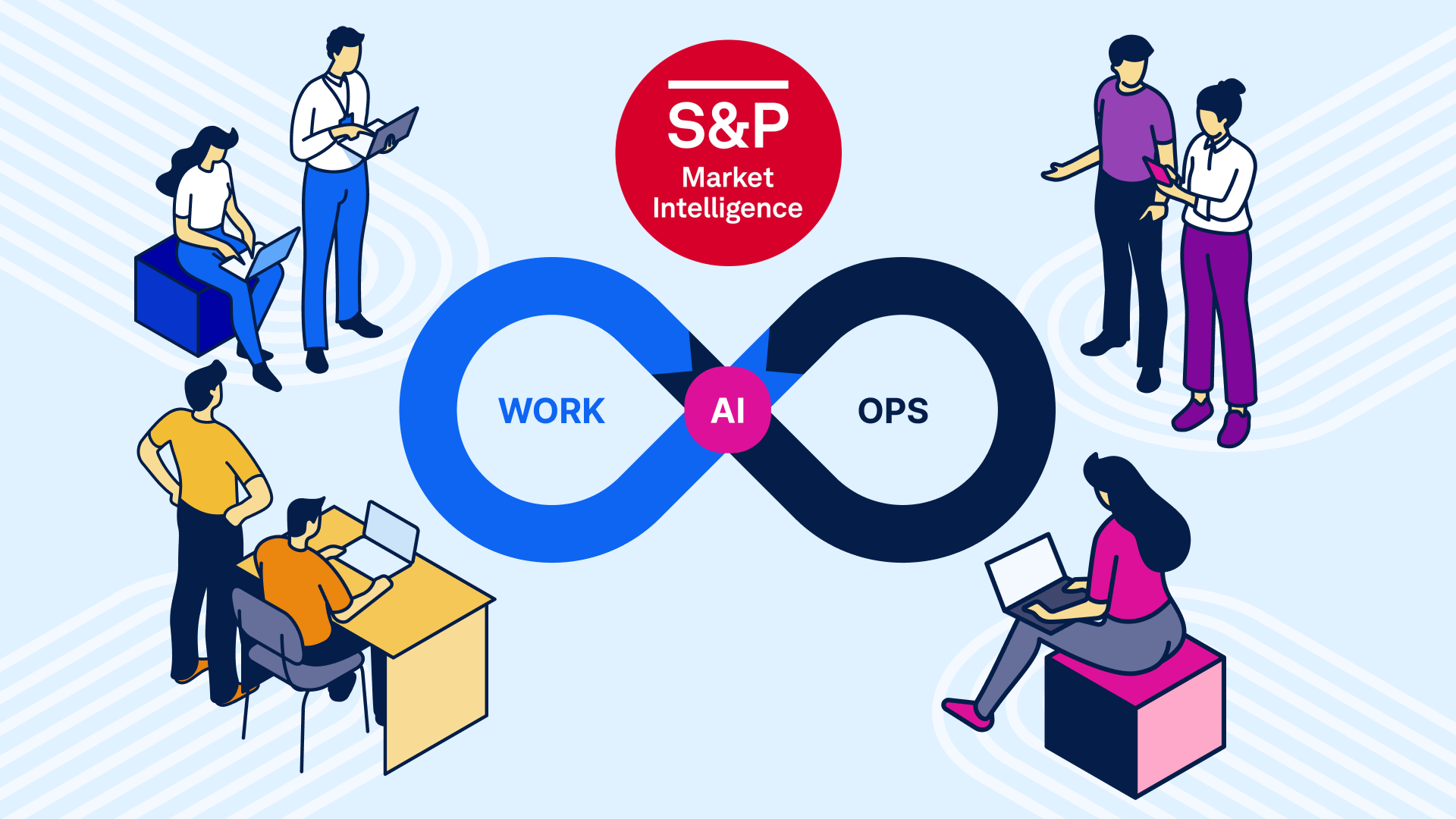
Table of contents
Why is traditional project management not enough?
WorkOps: The ecosystem of work
What is WorkOps?
What is not WorkOps?
The WorkOps infinity loop: How it works
Work in 4 phases
Operations in 4 phases
Breaking down the walls inside the company
Transition to WorkOps with Easy Redmine
What are the common objections and responses
Conclusion
TL;DR
Traditional project management is failing. Despite more tools than ever, 75% of IT projects are doomed from the start due to speed, silos (costing $75M per $1B spent), inflexibility, and fundamental mismatches with how modern work actually happens.
WorkOps is the solution—an ecosystem approach that orchestrates teams, processes, and AI into a unified system delivering continuous value through 8 interconnected phases: Planning, Delivery, Quality, Automations, Integrations, Support, Knowledge, and Reports.
The shift: Stop managing discrete projects. Start orchestrating continuous, adaptive, AI-powered work ecosystems. Project Managers evolve from administrators to strategic orchestrators.
Disclaimer
Our thinking on WorkOps was inspired by the early work of Chris Marsh from 451 Research (now part of S&P Global Market Intelligence), which introduced WorkOps as a future of work. We've evolved this framework to encompass AI and the complete ecosystem of work that modern organisations require in 8 phases.
Why is traditional project management not enough?
Project management, as we know it, is actually a rising trend. Companies know that at some point, team needs to manage their work beyond Excel, documents and internal apps. The problem is that project management was designed for a world that no longer exists.
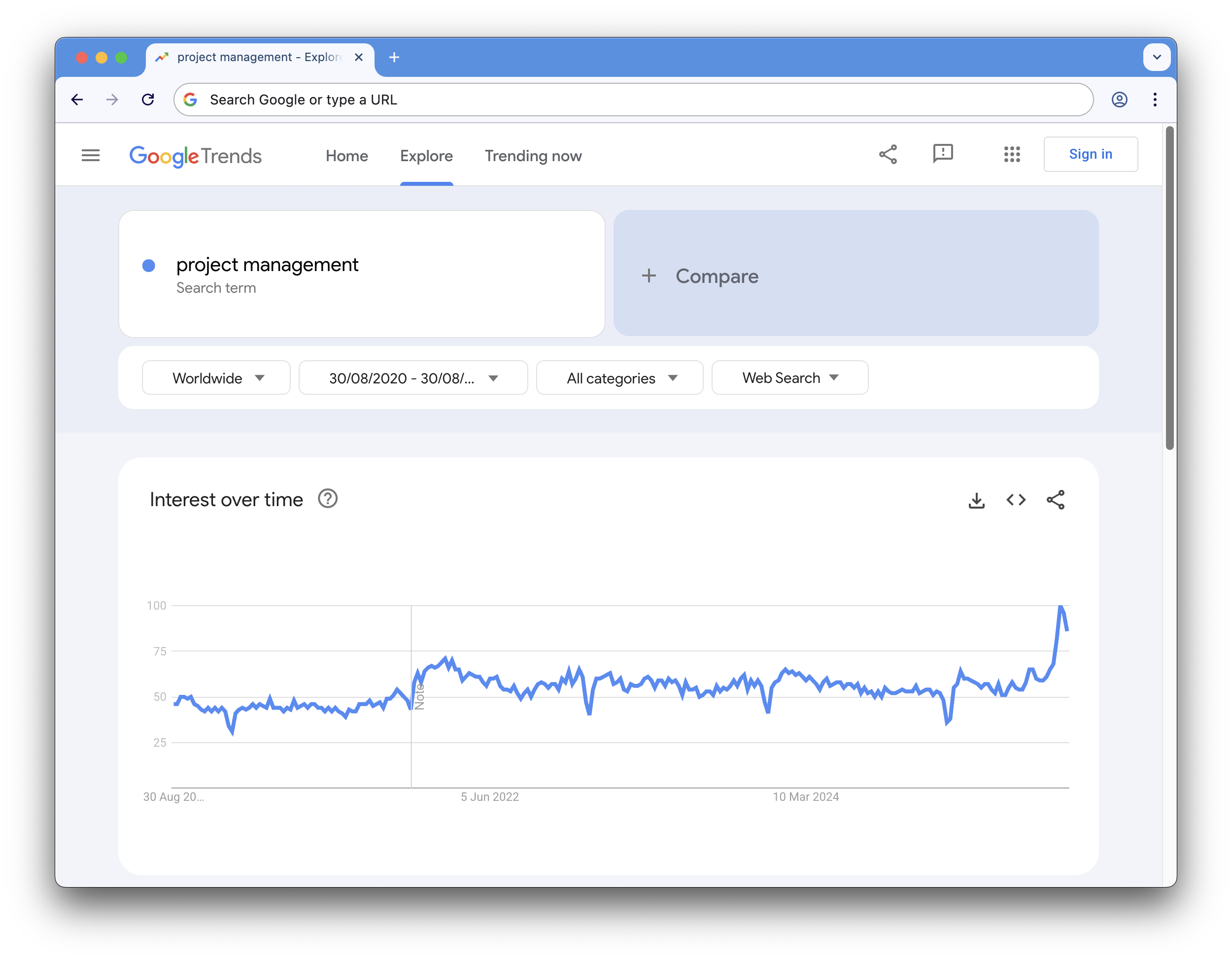
Project management topic in Google Trends (Aug 2025)
1. The project management fundamentals problem
Consider the evidence: despite having more sophisticated project management tools than ever before, 75% of IT professionals believe their projects are doomed from the start. It's an older article, but it's worth reading.
This isn't actually a tool's problem. Right now, there are thousands of solutions for PM. It's all about a fundamental mismatch between how we organise work and how work actually happens today.
2. The speed problem
Traditional project management operates on the assumption that you can plan, execute, and close projects in discrete phases. But modern business moves at a pace that makes this approach obsolete. By the time a traditional project plan is approved, the market has shifted, customer needs have evolved, and competitors have already launched.
The average enterprise now uses 46 disconnected tools across development, design, and product teams. Each tool promises efficiency, but together they create a fragmented landscape where organisations lack access to real-time project KPIs. IT Specialists and Project Managers spend their days chasing updates across platforms rather than driving strategic outcomes.
3. The silo problem
Perhaps nowhere is project management's limitation more apparent than in its failure to break down organisational silos. Most project failures stem from poor communication between teams. Departments operate as isolated kingdoms, each with their own tools, metrics, and priorities.
The cost of this fragmentation is staggering. PMI research suggests that working in silos and not sharing data between departments can cost a company $75 million for every $1 billion spent on a project. Project Managers find themselves acting as translators between teams that should be collaborating seamlessly.
4. The problem of inflexibility
Traditional project management assumes predictability—that requirements can be gathered, scope can be defined, and resources can be allocated according to plan. But projects fail to meet their goals due to a lack of alignment between business and project objectives.
The waterfall-versus-agile debate misses the point entirely. Both methodologies still operate within the constraints of project-based thinking. They assume work has clear beginnings and endings, that teams are stable, and that value is delivered in discrete packages. Modern work is continuous, teams are fluid, and value must be delivered in real-time.
WorkOps: The ecosystem of work
WorkOps represents a fundamental shift in how we conceptualise and execute work. Rather than managing projects, WorkOps creates an ecosystem where work flows continuously, adapting to change in real-time.
What is WorkOps?
WorkOps is the orchestration of teams, processes, and technology into a unified system that delivers continuous value. It treats the entire organisation as an interconnected network rather than a collection of separate projects and departments.
Think of it this way: if project management is like conducting a single orchestra, WorkOps is like managing a jazz festival—multiple ensembles playing simultaneously, improvising based on audience response, yet somehow creating a cohesive experience.
At its core, WorkOps recognises that modern work is:
- Continuous rather than discrete: Work doesn't stop when a project ends
- Interconnected rather than isolated: Every action affects multiple teams and outcomes
- Adaptive rather than predictive: Plans must evolve in real-time based on data and feedback
- Intelligent rather than manual: AI and automation handle routine decisions, freeing humans for strategic thinking
What is not WorkOps?
WorkOps isn't simply "better project management" or "agile at scale". It's not about adding more tools or creating more processes. It's not about replacing Project Managers—in fact, it elevates their role from administrators to strategic orchestrators.
Most importantly, WorkOps isn't a one-size-fits-all methodology. It's a modern work methodology that adapts to your organisation's unique context, culture, and challenges.
The WorkOps infinity loop: How it works
The WorkOps framework operates as an infinite loop consisting of 8 phases, where each phase feeds into and strengthens the others. This creates a self-reinforcing system that becomes more effective over time.
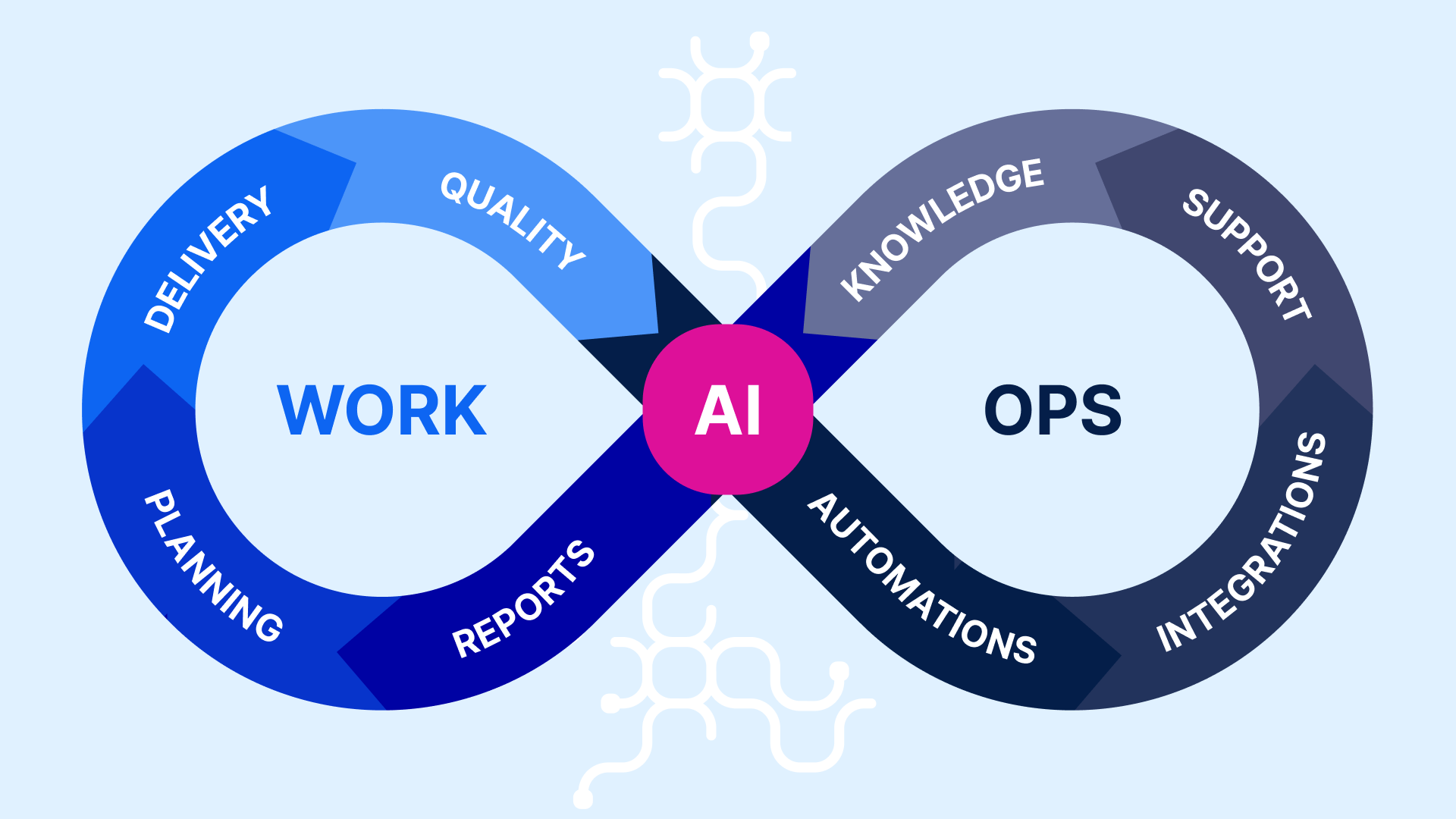
WorkOps infinity loop with 8 work & ops phases
Work in 4 phases
- Reports: They aren't just backwards-looking dashboards - they're real-time business intelligence that drives the next cycle or iteration of work. WorkOps generates insights (thanks to AI), identifies opportunities, and continuously refines how work gets done.
- Planning: WorkOps eliminates the artificial boundaries between strategic planning, project planning, and daily execution. Instead of separate systems for each level, it creates a unified planning architecture where strategy translates directly into executable work.
- Delivery: Rather than forcing teams to choose between Waterfall (with Gantt Charts), Agile (with Kanban Boards), or other methodologies, WorkOps allows a hybrid approach where methodologies coexist and complement each other.
- Quality: It isn't something you only check at the end; it's an integral part of the entire work cycle. WorkOps platform embeds quality gates, compliance checks, and validation steps directly into workflows, making quality assurance continuous rather than retrospective.
Operations in 4 phases
- Automations: WorkOps transforms repetitive work into automated workflows, enabling people to grow in creative and strategic tasks. And for more sophisticated tasks, AI agents can simplify processes daily with a human touch and feedback loop.
- Integrations: Instead of adding yet another tool to the stack, WorkOps creates an integration layer that makes existing tools work together seamlessly (thanks to platforms like n8n). And AI can provide insights for individuals: Project Managers can make informed, fast, and precise decisions by pulling data from across all platforms.
- Support: WorkOps doesn't just execute work; it learns from every interaction, becoming more effective over time. This creates a system that not only delivers projects but continuously improves how work gets done.
- Knowledge: It isn't locked in documents or people's heads - it's captured, organised, and available where needed. WorkOps treats knowledge as a living system that grows smarter with every project.
Breaking down the walls inside the company
Okay, sounds interesting, right? But how can companies actually implement it? The shift from project management to WorkOps requires dismantling several organisational barriers that have calcified over decades.
- Cultural transformation: The biggest barrier isn't technological—it's cultural. Success with AI implementation hinges on cultural acceptance and employee engagement. Organisations must shift from a command-and-control mindset to one of orchestration and empowerment.
- Data integration & automation: Without data integration, AI agents can't make autonomous decisions, and automation creates more problems than it solves. WorkOps advocates for incremental integration, starting with the highest-value workflows and expanding systematically.
- Skills evolution: Project Managers won't become obsolete in a WorkOps world—they'll become more valuable. But their skills must evolve. Tomorrow's project leaders need to understand AI capabilities, data analysis, and systems thinking. They must be comfortable with ambiguity and skilled at orchestrating both human and artificial intelligence.
Transition to WorkOps with Easy Redmine
The transition to WorkOps doesn't require abandoning your existing investments. Platforms like Easy Redmine can serve as the foundation for WorkOps transformation by providing:
- One platform that breaks down silos between teams.
- The hybrid methodology allows Waterfall, Agile to coexist.
- Integration capabilities with n8n that connect with your existing tool ecosystem.
- AI-ready architecture that can incorporate intelligent automation and decisioning.
- Real-time visibility across all projects and resources, the helicopter view.
The key is to think beyond project management software as a tracking tool and reimagine it as the nervous system of your WorkOps ecosystem—sensing, responding, and adapting to the continuous flow of work.
What are the common objections and responses
"This sounds too complex for our organisation."
WorkOps actually simplifies work by eliminating the complexity created by disconnected tools and processes. You don't implement WorkOps overnight—you evolve toward it, gaining value at each automation/integration. It's like your north star for your way of working.
"We've invested too much in our current project management approach."
WorkOps doesn't require abandoning your investments. It builds beyond them, making your existing tools and processes more effective through intelligent orchestration.
See the schema below how it looks in practice.
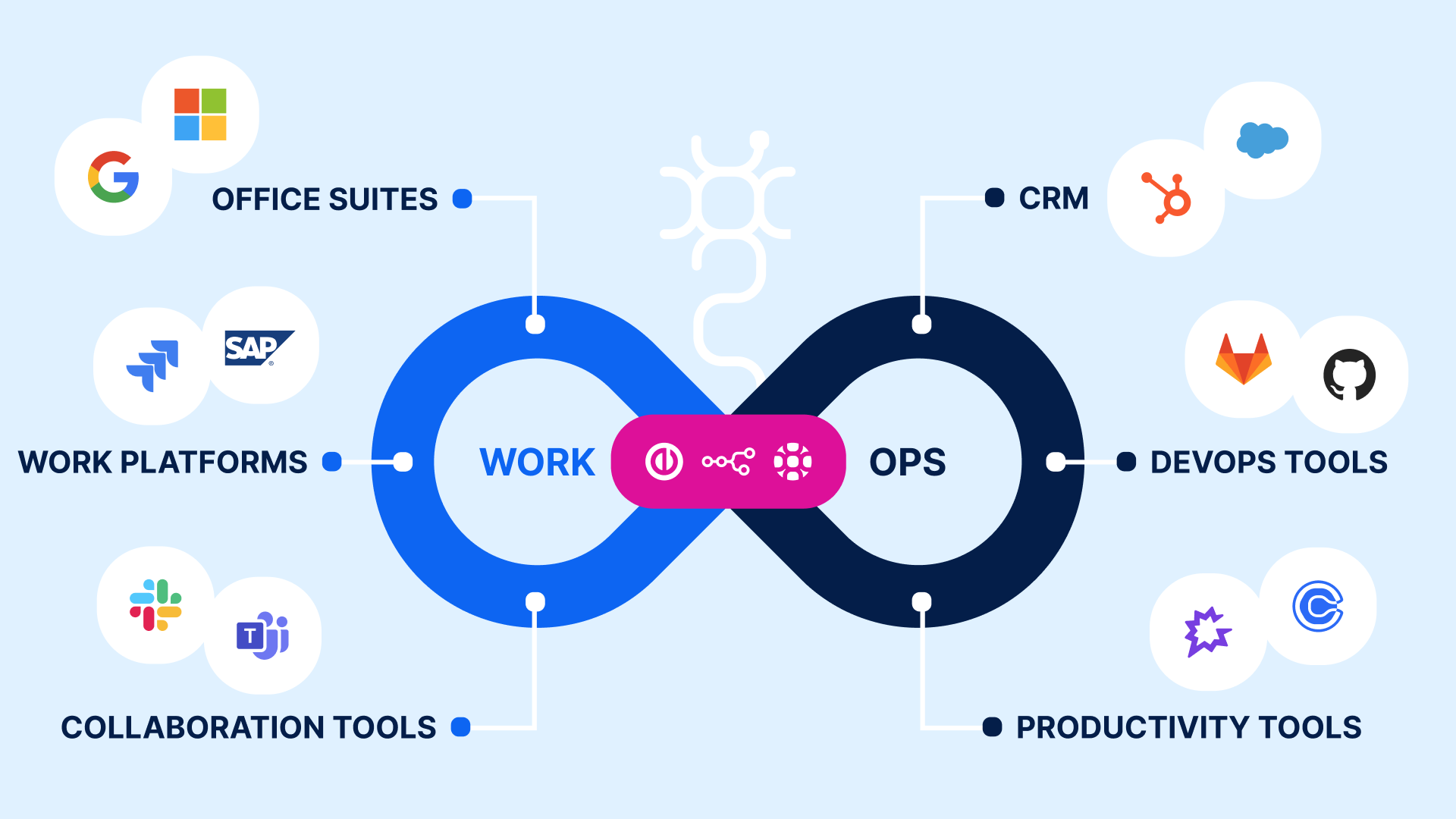
Most popular enterprise tools in each WorkOps phase of the infinity loop
"Our industry is too regulated for this flexibility."
Easy Redmine WorkOps excels in regulated environments by ensuring compliance is built into every workflow (also with AI). Monitor regulatory requirements in real-time, automatically adjusting processes to maintain compliance while maximising flexibility where possible.
"This will make Project Managers redundant."
Quite the opposite. WorkOps elevates Project Managers from administrative tasks to strategic orchestration. Project Managers who stay at the forefront of emerging technologies and help drive AI adoption will best position themselves for career success.
Conclusion
The evidence is overwhelming: traditional project management cannot solve modern work challenges and complexity. Organisations continue to apply yesterday's solutions to tomorrow's problems.
WorkOps isn't a futuristic vision—it's happening now. Forward-thinking organisations are already implementing elements of the WorkOps framework. The question isn't whether to adopt WorkOps, but how quickly you can begin the transformation.
The tools exist. The technology is mature. The only remaining barrier is the willingness to reimagine how work gets done.
Traditional project management served us well in a predictable, linear world. But that world no longer exists. It's time to stop managing projects and start orchestrating ecosystems. It's time for WorkOps.


